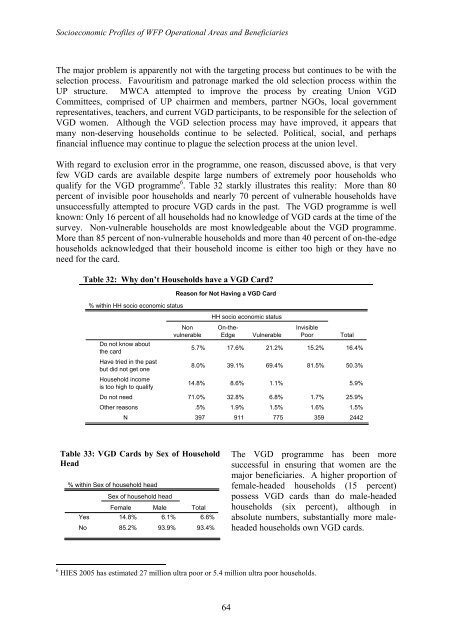RURAL BANGLADESH - PreventionWeb
RURAL BANGLADESH - PreventionWeb
RURAL BANGLADESH - PreventionWeb
Create successful ePaper yourself
Turn your PDF publications into a flip-book with our unique Google optimized e-Paper software.
Socioeconomic Profiles of WFP Operational Areas and Beneficiaries<br />
The major problem is apparently not with the targeting process but continues to be with the<br />
selection process. Favouritism and patronage marked the old selection process within the<br />
UP structure. MWCA attempted to improve the process by creating Union VGD<br />
Committees, comprised of UP chairmen and members, partner NGOs, local government<br />
representatives, teachers, and current VGD participants, to be responsible for the selection of<br />
VGD women. Although the VGD selection process may have improved, it appears that<br />
many non-deserving households continue to be selected. Political, social, and perhaps<br />
financial influence may continue to plague the selection process at the union level.<br />
With regard to exclusion error in the programme, one reason, discussed above, is that very<br />
few VGD cards are available despite large numbers of extremely poor households who<br />
qualify for the VGD programme 6 . Table 32 starkly illustrates this reality: More than 80<br />
percent of invisible poor households and nearly 70 percent of vulnerable households have<br />
unsuccessfully attempted to procure VGD cards in the past. The VGD programme is well<br />
known: Only 16 percent of all households had no knowledge of VGD cards at the time of the<br />
survey. Non-vulnerable households are most knowledgeable about the VGD programme.<br />
More than 85 percent of non-vulnerable households and more than 40 percent of on-the-edge<br />
households acknowledged that their household income is either too high or they have no<br />
need for the card.<br />
% within Sex of household head<br />
Yes<br />
No<br />
Table 32: Why don’t Households have a VGD Card?<br />
% within HH socio economic status<br />
Do not know about<br />
the card<br />
Have tried in the past<br />
but did not get one<br />
Household income<br />
is too high to qualify<br />
Do not need<br />
Other reasons<br />
N<br />
Sex of household head<br />
Female Male<br />
Total<br />
14.8% 6.1% 6.6%<br />
85.2% 93.9% 93.4%<br />
Reason for Not Having a VGD Card<br />
Non<br />
vulnerable<br />
Table 33: VGD Cards by Sex of Household<br />
Head<br />
HH socio economic status<br />
On-the-<br />
Edge Vulnerable<br />
5.7% 17.6% 21.2% 15.2% 16.4%<br />
8.0% 39.1% 69.4% 81.5% 50.3%<br />
14.8% 8.6% 1.1% 5.9%<br />
71.0% 32.8% 6.8% 1.7% 25.9%<br />
.5% 1.9% 1.5% 1.6% 1.5%<br />
397 911 775 359 2442<br />
64<br />
Invisible<br />
Poor<br />
Total<br />
The VGD programme has been more<br />
successful in ensuring that women are the<br />
major beneficiaries. A higher proportion of<br />
female-headed households (15 percent)<br />
possess VGD cards than do male-headed<br />
households (six percent), although in<br />
absolute numbers, substantially more maleheaded<br />
households own VGD cards.<br />
6 HIES 2005 has estimated 27 million ultra poor or 5.4 million ultra poor households.












![View full document [PDF 988.55 KB] - PreventionWeb](https://img.yumpu.com/47733942/1/184x260/view-full-document-pdf-98855-kb-preventionweb.jpg?quality=85)
![View full document (in French) [PDF 4.96 MB] - PreventionWeb](https://img.yumpu.com/47223870/1/184x260/view-full-document-in-french-pdf-496-mb-preventionweb.jpg?quality=85)


![View full document [PDF 25.02 MB] - PreventionWeb](https://img.yumpu.com/44204570/1/190x234/view-full-document-pdf-2502-mb-preventionweb.jpg?quality=85)
